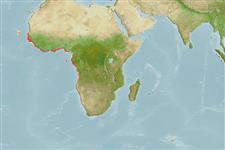Common names from other countries
Environment: milieu / climate zone / depth range / distribution range
Ecologia
; intervalo de profundidade 0 - 90 m (Ref. 435), usually 4 - 40 m (Ref. 435). Tropical; 17°N - 19°S, 25°W - 14°E
Eastern Atlantic: Western African coast from Mauritania to Namibia.
Length at first maturity / Tamanho / Peso / Idade
Maturity: Lm ? range ? - ? cm Max length : 10.8 cm CW macho/indeterminado; (Ref. 435)
Occurs at depths from shore to 90 m (Refs. 435, 2708); common at depths of 4 to 40 m. Burrows in sand or fine gravel and also in bottoms with other sediments. (Ref. 435). Can live on all level substrates but may prefer sand (Ref. 2708). In general, Calappa feeds upon molluscs and hermit crabs in gastropod shells. Their right claw is used for crushing shells of prey while their left claw is used as a cutter (Ref. 105092).
Life cycle and mating behavior
Maturidade | Reprodução | Desova | Ovos | Fecundidade | Larvas
Members of the order Decapoda are mostly gonochoric. Mating behavior: Precopulatory courtship ritual is common (through olfactory and tactile cues); usually indirect sperm transfer.
Fischer, W., G. Bianchi and W.B. Scott (eds.). 1981. (Ref. 435)
Categoria na Lista Vermelha da IUCN (Ref. 130435)
Categoria CITES (Ref. 108899)
Not Evaluated
Not Evaluated
Ameaça para o homem
Harmless
Utilização humana
Pescarias: espécies comerciais
| FishSource |
Ferramentas
Mais informação
Idade/TamanhoCrescimentoComprimento-pesoComprimento-comprimentoMorfologiaLarvasAbundância
Fontes da internet
Estimates based on models
Preferred temperature
(Ref.
115969): 21.7 - 28, mean 26.2 (based on 116 cells).
Vulnerabilidade
Low vulnerability (10 of 100).
Categoria de preço
Unknown.
